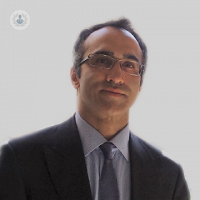How is a macular hole treated?
Written in association with:The macula is an area in the centre of the retina which makes it possible to see fine detail which is needed for tasks such as reading. When a hole develops in the macula it can cause blurred and distorted central vision, this can be unnerving when it suddenly happens. Straight lines may look wavy and it becomes more difficult to read. As the hole develops, a small black patch appears in the centre of your vision. It is painless and doesn’t lead to a total loss of sight. It normally occurs in people over 60. If you are experiencing these symptoms you need to see an ophthalmologist.

Vitrectomy surgery
Surgery is usually necessary and the operation is called a vitrectomy. Though it is often successful and does improve vision, sight is not fully restored. If you’ve had the hole for less than a year, there’s around a 90% or greater chance the operation will succeed in closing it. In a minority of patients the hole doesn’t close despite surgery and continues to degenerate. After surgery, a cataract will develop and this means the natural lens in the eye becomes cloudy with loss of vision. Your surgeon can recommend a combined lens replacement operation at the same time as the vitrectomy operation and this means you will not suffer a cataract in future.
The procedure
It is a form of keyhole surgery performed under a microscope. Three small incisions are made in the white of the eye and the vitreous jelly is removed. Then a very delicate layer is carefully peeled off the surface of the retina around the macular hole, to release the forces that keep the hole open. A gas bubble is then inserted, which presses the hole flat onto the back of the eye to keep it sealed. The bubble of gas slowly disappears over a period of about three weeks. You cannot fly for three weeks following the operation with a gas bubble.The procedure usually takes 45 minutes and can be done while you're awake (under local anaesthetic) with sedation to relax you, or asleep (under general anaesthetic). It is common for you to go home the same day, and sutures are not used commonly for the operation. This means the eye itself heals rapidly over one to two weeks after surgery.
Post-operative
The eye is padded up to protect it though this can be removed in a day or two. The patient experiences poor vision until the gas bubble disappears (three weeks), balance is affected and it’s difficult to judge distances. The eye may be feel sore and sensitive and you will require to take eye drops
Ocriplasmin injection
If vitreomacular traction is the cause of the macular hole and the hole is in the very early stages, it may be possible to treat it with an injection of ocriplasmin into the eye. The injection separates the vitreous jelly from the back of the eye and allows the macular hole to close. The injection only takes a few seconds and you're given a local anaesthetic so it’s painless. Normal vision normally returns after one day. It only has a success rate of around 50% so vitrectomy surgery is necessary when it doesn’t work.


